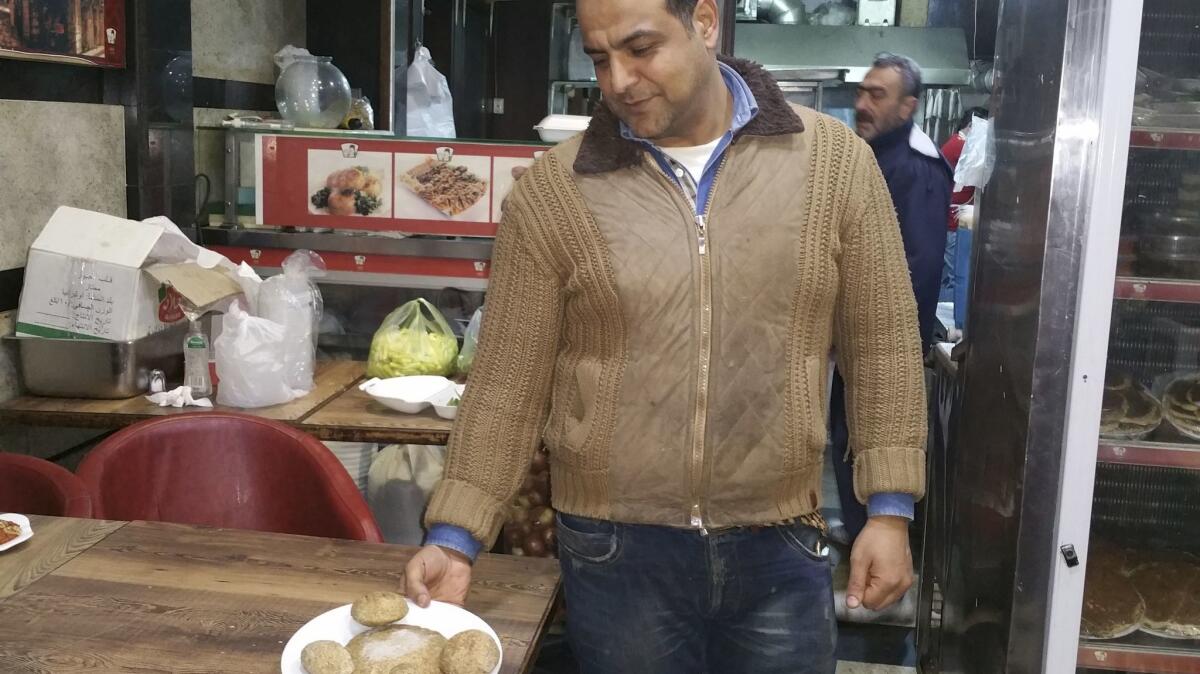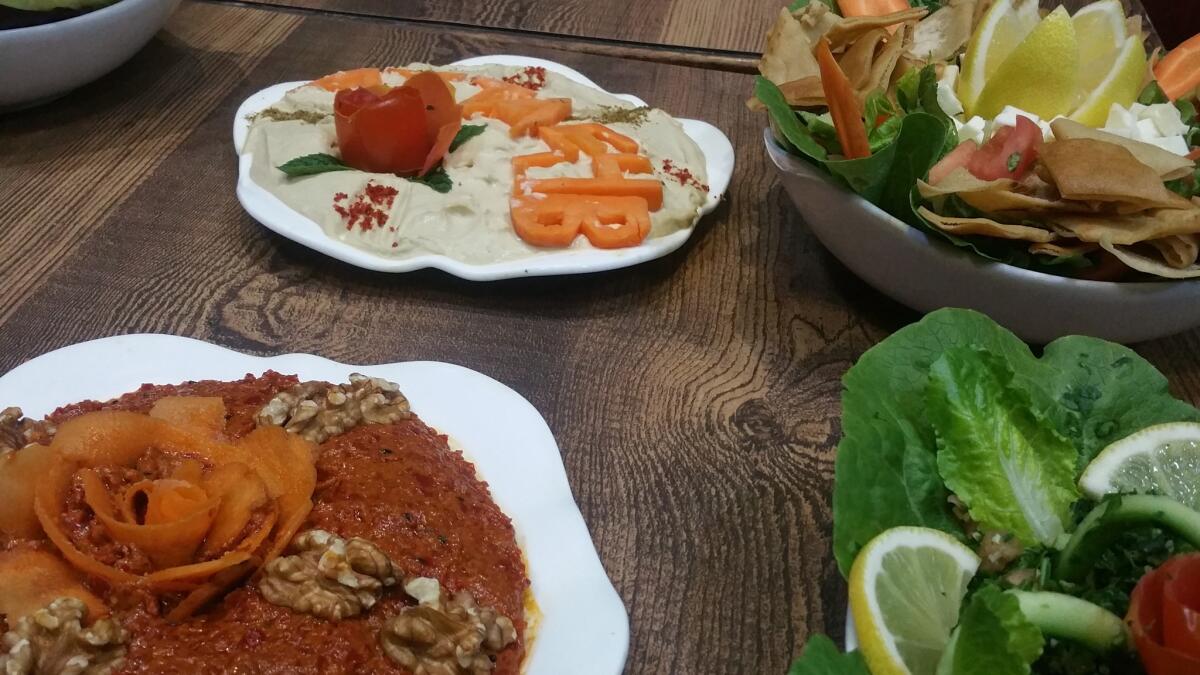Meet the culinary zealot fighting to preserve Syrian cuisine despite years of war

Atayeb Kajaan and his brother Ahmad Kajaan operate Atayeb, a restaurant in Khaldiyeh, a neighborhood in northwest Aleppo.
Reporting from Aleppo, Syria — Each time Saameh Kajaan talks about food in the Syrian city of Aleppo, a true culinary zealot emerges.
The restaurateur is so serious about local dishes that along with his black, slicked-back hair, confident charisma and 40-year-old bulky frame, he could pass for a Hollywood-type mobster.
“Our homes are all schools for learning how to cook,” he said recently in a tone that belied his good nature. “It comes from Aleppo’s air, its environment … the four seasons we have here.”
Kajaan’s devotion to traditional food has remained intense despite Aleppo’s transition in recent years from a booming metropolis to a symbol of suffering brought on by the battles between forces loyal to President Bashar Assad and opposition factions based in the city’s eastern neighborhoods.
The nearly six-year conflict in Syria — which stayed mostly clear of Aleppo during the first year — has claimed more than 400,000 lives and caused millions of residents to flee their homes, in many cases making their way to other countries.
The devastation has been so great that outgoing United Nations Secretary-General Ban Ki-moon in December said Aleppo had become a synonym for hell.
“We have collectively failed the people of Syria,” Ban told reporters in New York. “Peace will only prevail when it is accompanied by compassion, justice and accountability for the abominable crimes we have seen.”

All kinds of businesses and factories have been looted or destroyed in the heat of war, but some have managed to survive. Among those is Atayeb, the restaurant where Kajaan and his brother Ahmad, 44, serve up a sumptuous Aleppan feast every day.
The brothers take pride in the city’s status before the war as arguably the food capital of the region. Its history includes invaders and inhabitants with varied roots who brought their influence to the (dinner) table.
Among the iconic dishes they offer are safarjaliyeh, where the tartness and sweetness of quince form the counterpoint to a simple tomato-based lamb stew; kibbeh labaniyah, one of 17 types of bulgur (cracked wheat) and minced lamb, this particular version dunked in a garlic-infused heavy yogurt; sindwanat, spheres of intestine stuffed with aromatic rice and meat cooked in traditional ghee. Customers pay a hefty $5 or $6 per meal.
Both Saameh and Ahmad, a taciturn, bespectacled wizard too engrossed in the kitchen to answer more than a few questions, attribute their gastronomic mastery to their mother.
“We were five brothers. My father had died, and so we were all in the kitchen together: One person fries, another person chops. … It was a matter of making things easier for my mother,” Saameh Kajaan said. “Her taste in cooking is what she bequeathed us.”
The two brothers opened Atayeb in Khaldiyeh, a neighborhood in northwest Aleppo that Saameh described as a one-time mecca for the lunch crowd of white-collar workers from all over the city.
However, when the fighting reached Aleppo, a year after it had spread elsewhere in the country, Khaldiyeh became a front line.
Atayeb remained open in the neighborhood until the end of 2013, but finally, the brothers had to move the business.
“The buildings were on the ground. It was mass destruction,” Saameh Kajaan said. “But when we left Khaldiyeh, we didn’t stop. We took two hours to set up in the new location and started work immediately.”
The new Atayeb, a shabby-looking hole-in-the-wall in the commercial Muhafaza neighborhood, about two miles from the original location, can barely contain four drab wooden tables and a cash register. Those seeking a more refined ambiance can have their Atayeb-made meals served at the cafe next door.
But why give up a front-row seat to the alchemy taking place a few feet away?
Many Atayeb customers wait for their takeout orders, which make up the bulk of the business, while lingering outside the kitchen watching the meals being prepared.
Those who chat with Saameh Kajaan rarely resist ordering some of Atayeb’s side dishes, like fresh tabbouleh salad or fried kibbeh, with their meals. Some offer a quick nod of thanks before moving along with their bags of food.

At the kitchen’s entrance, workers Um Mahmoud and Um Ismail sit at a metal table, making quick work of a bowl of vine leaves. They place a handful of rice and meat in the center of a leaf before deftly rolling it to make cigar-like pieces of yabra’a.
In the kitchen, other employees are no less industrious, preparing kibbeh, cutting up vegetables and chicken or keeping close watch over a bubbling vat of large meat chunks swimming amid bay leaves.
Throughout the kitchen, there is a heady aroma of ingredients. It’s all the result of a process that begins before 8 in the morning, when Saameh Kajaan, the designated supplier, begins his shopping spree for ingredients facing war-related shortages. He approaches his task with puritanical exactitude.
“I have no set menu. I go to the market. … What I like becomes my menu,” Kajaan said, explaining that he feels no obligation to offer a dish if the ingredients are not up to standard.
He beckons for a small bowl of olive oil and a bucket of yogurt at the restaurant.
“Taste this. I could get cheaper oil, but I’m adding five drops to each plate of Hummus and make only 100 of them per day,” he said. “They better be good. I get it straight from a farm.”
The same applies to the six sheep carcasses Atayeb requires every day. A butcher from the restaurant checks for color, age, amount of fat and whether the sheep has been vaccinated.
“Some people would allow such ingredients in their restaurant. I don’t,” Kajaan said.
The Kajaans are constantly on the lookout for spices or techniques to improve the cooking process. Saameh Kajaan, for example, discovered after some research that kiwi fruit is a natural meat tenderizer.
At work one day, he brought out two plates piled with lahm bi ajeen, paper-thin meat pies that come either in a piquant Armenian version or a local variant that flavors the meat with pomegranate molasses.
“I’m serving a certain segment of population — those who know what tastes good,” Kajaan said.
Before long, the meat pies were gone, as customers wasted little time in claiming them.
Bulos is a special correspondent.
MORE WORLD NEWS
Gambian leader who once said only God could remove him cedes power under military pressure
In India, the bullfight might go on as officials vow to defy a ban on controversial sport
Brazil investigates plane crash that killed judge overseeing massive ‘Car Wash’ corruption case
Fear, concern but also Champagne — the world reacts to Donald Trump’s inauguration
More to Read
Sign up for Essential California
The most important California stories and recommendations in your inbox every morning.
You may occasionally receive promotional content from the Los Angeles Times.









